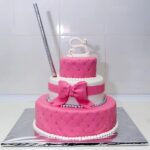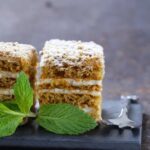Cake decorating rollers are essential tools that can take your cake decorating skills to the next level. These versatile instruments allow for precise and intricate designs, adding a professional touch to your cakes. Whether you’re a beginner or an experienced cake decorator, understanding the importance of cake decorating rollers and how they can enhance your overall cake decorating experience is key.
When it comes to cake decorating rollers, there is a wide variety of options available in the market. From fondant rollers to embossing rollers and patterned rollers, each type serves a specific purpose in creating beautiful cake decorations. Understanding the different types of cake decorating rollers will help you choose the right one for your desired technique and design.
Choosing the right cake decorating roller can make a significant difference in achieving your desired results. Consider factors such as your individual preferences, skill level, and the type of decoration you aim to create when selecting a roller. With numerous options available, it’s important to know which roller will work best for you and your specific cake decorating needs.
In the following sections of this article, we will delve deeper into various aspects of using cake decorating rollers. From step-by-step instructions on how to use them properly to advanced techniques that unlock endless creative possibilities, we will provide you with all the information you need to master cake decoration with these handy tools. Let’s get started.
Understanding the Different Types of Cake Decorating Rollers
When it comes to cake decorating, having the right tools can make all the difference. Cake decorating rollers are an essential tool for any baker looking to enhance their cake decoration skills. These rollers are designed to help create smooth and professional-looking finishes, add intricate designs, and imprint patterns onto cakes. In this section, we will explore the various types of cake decorating rollers available in the market, including fondant rollers, embossing rollers, and patterned rollers.
1. Fondant Rollers:
Fondant is a popular choice for cake decorators as it allows for a smooth and flawless finish. Fondant rollers are specifically designed to roll out fondant evenly and achieve an even thickness throughout. These rollers are usually wider compared to other types of cake decorating rollers and often come with additional accessories like spacers or guides that allow bakers to achieve precise thicknesses when rolling out the fondant.
2. Embossing Rollers:
Embossing rollers are ideal for adding texture and depth to cake decorations. These rollers have intricate designs or patterns engraved on them, which can be pressed onto various mediums such as fondant or gum paste. By rolling over a piece of fondant with an embossing roller, bakers can easily create visually appealing textures that elevate their cake designs.
3. Patterned Rollers:
Patterned rollers are perfect for adding decorative elements and unique designs to cakes quickly. These rollers feature patterns such as lace, flowers, or geometric shapes that can be imprinted onto rolled fondant or other soft mediums easily. With patterned rollers, bakers can effortlessly add elegance and complexity to their cake decorations.
As every type of roller serves different purposes in cake decorating, it is important for bakers to have a collection of these tools in their arsenal. By understanding the different types of cake decorating rollers available in the market like fondant rollers, embossing rollers, and patterned rollers, bakers can choose the appropriate tool for each cake design and achieve stunning results.
Tips for Choosing the Right Cake Decorating Roller
Consider Your Skill Level
When choosing a cake decorating roller, it’s important to consider your skill level. If you’re a beginner or just starting out with cake decorating, it may be best to start with a basic fondant roller. These rollers are typically smooth and easy to use, making them perfect for beginners who may not have much experience.
For more advanced decorators who are comfortable working with fondant, embossing rollers can be a great option. These rollers feature raised designs that can easily be pressed into fondant to create beautiful patterns and textures. While they may require a bit more skill to use, the results can be incredibly impressive.
Determine Your Decoration Style
Another important factor to consider when choosing a cake decorating roller is the type of decoration you want to achieve. If you prefer clean and simple designs, a patterned roller with pre-designed shapes or patterns may be the best choice for you. These rollers allow for quick and easy application of consistent designs, perfect for creating elegant cakes with minimal effort.
On the other hand, if you enjoy creating intricate and detailed designs, an embossing roller can give you the ability to add depth and texture to your cakes. These rollers often feature intricate motifs or floral patterns that can add a touch of sophistication to your creations.
Take Individual Preferences into Account
Lastly, it’s important to take your individual preferences into account when choosing a cake decorating roller. Consider factors such as size, weight, and handle design. Some decorators may prefer smaller rollers that fit comfortably in their hands while others may prefer larger ones for quicker coverage.
Additionally, think about the material of the roller itself. Some decorators prefer plastic rollers as they tend to be lightweight and easy to clean while others prefer wooden or metal rollers for their durability and stability.
By considering your skill level, decoration style preferences, and individual needs, you can choose the ideal cake decorating roller that will enhance your cake decorating experience and make the process more enjoyable.
How to Use Cake Decorating Rollers
To properly use cake decorating rollers, follow these step-by-step instructions:
Rolling Fondant
- Start by kneading the fondant to make it pliable and easy to work with.
- Dust your work surface and rolling pin with powdered sugar or cornstarch to prevent sticking.
- Flatten the fondant into a disk shape and place it on the dusted surface.
- Begin rolling from the center of the fondant outwards, applying even pressure as you go.
- Lift and turn the fondant occasionally to ensure it doesn’t stick to the surface.
- Continue rolling until you achieve your desired thickness for covering the cake or creating decorations.
Creating Intricate Designs
- Attach the desired pattern or design roller onto a handle if necessary.
- Roll out a thin sheet of fondant or gum paste using a regular rolling pin.
- Position the pattern roller at one end of the icing sheet and gently roll over it, ensuring even pressure.
- Move the roller along in a straight line, overlapping slightly with each roll to create a continuous pattern.
- Repeat this process as needed for your design, ensuring consistent pressure and alignment.
Imprinting Patterns
- Select a patterned roller with an intricate design of your choice.
- Roll out a thin layer of gum paste or fondant using a regular rolling pin.
- Place your chosen patterned roller on one end of the rolled-out icing sheet.
- Apply firm and even pressure as you roll over the roller from one end to another.
- Lift off the roller carefully to reveal an impressive imprinted pattern on your icing.
Remember to practice these techniques before working on your actual cake decoration. Familiarize yourself with how much pressure is required for different outcomes. Additionally, keep in mind that excessive usage of force while rolling may distort delicate patterns or texturing on the rollers. With patience and practice, using cake decorating rollers will become second nature, allowing you to create beautiful designs and textures for your cakes.
Advanced Techniques with Cake Decorating Rollers
Using multiple cake decorating rollers can add a layered effect and enhance the overall visual appeal of a cake. By combining different patterns, textures, and designs, decorators can create truly unique and eye-catching decorations. This technique allows for endless creative possibilities, as decorators can experiment with various combinations to achieve their desired results.
When using multiple rollers, it is important to consider the size and scale of the cake. Using too many different patterns or textures on a small cake may overwhelm the design, while using only one or two patterns on a larger cake could appear too sparse. It is also essential to ensure that the colors used in the different patterns complement each other and harmonize with the overall theme of the cake.
To start incorporating multiple rollers into your cake decorating process, begin by selecting two or three rollers with complementary patterns or textures. Roll out your fondant or modeling chocolate using a smooth roller first, ensuring it is large enough to cover the entire surface of the cake. Once you have a smooth layer, lay down your first patterned roller at one end and roll it gently across the surface of the fondant or chocolate.
Next, repeat this process with your second roller, slightly overlapping with or connecting its pattern to the first roller. This creates an interesting layered effect that adds depth and dimension to your cake decoration. For more advanced techniques, you can even incorporate additional layers with different patterns or textures.
Another technique that can be achieved with multiple rollers is creating unique textures on your cake decorations. Experimenting with rollers that have raised designs like lace or floral impressions can add intricate detailing to your cakes. Combining these textured rollers with smoother ones creates contrast and makes certain features stand out more prominently.
Overall, using multiple cake decorating rollers allows for endless creativity and experimentation in designing visually stunning cakes. By combining different patterns and textures, decorators can achieve unique effects that elevate their designs to another level.
Troubleshooting Common Issues
Cake decorating rollers can be a valuable tool for creating beautiful and intricate cake designs. However, like any other tool, they may come with their own set of challenges. In this section, we will address some common issues faced while using cake decorating rollers and provide practical solutions to ensure a successful cake decorating experience.
One common issue that many cake decorators face is the sticking of fondant or other cake decorating materials to the roller. This can make it difficult to roll out the fondant smoothly and may result in tearing or uneven distribution. To prevent this issue, it is important to properly prepare your roller before use.
One effective method is to lightly dust the roller with cornstarch or powdered sugar before rolling out the fondant. This will create a barrier between the material and the roller, allowing for smoother rolling without sticking.
Another challenge encountered when using cake decorating rollers is achieving a consistent thickness throughout the rolled out fondant or dough. Inconsistencies in thickness can affect the overall appearance of the cake decoration and may lead to an unevenly baked cake. To overcome this issue, consider using guide rings or spacers that are specifically designed for cake decorating rollers. These rings can be placed on both ends of the roller and act as guides for ensuring an even thickness.
Additionally, applying too much pressure while rolling out your fondant or dough can also result in unwanted stretching or tearing. It is important to roll gently and evenly to avoid these issues. If you find that your material is becoming too thin or starting to tear during rolling, try applying less pressure and rolling more slowly.
| Common Issues | Solutions |
|---|---|
| Fondant/material sticking to roller | Lightly dust roller with cornstarch/powdered sugar |
| Inconsistent thickness | Use guide rings/spacers for even rolling |
| Stretching or tearing of material | Apply less pressure and roll more gently |
By addressing these common challenges and implementing the suggested solutions, cake decorators can overcome potential obstacles and achieve smoother, more professional-looking results. Troubleshooting and understanding how to use cake decorating rollers effectively will enhance your cake decorating experience and allow you to unleash your creativity without limitations.
Maintenance and Care of Cake Decorating Rollers
Cleaning Cake Decorating Rollers
Proper cleaning is essential to maintain the performance and longevity of your cake decorating rollers. After each use, it is important to remove any excess fondant or icing from the roller. Start by wiping down the roller with a clean, damp cloth to remove any residue.
For more stubborn debris, you can use a small amount of warm, soapy water and gently scrub the roller with a soft brush or sponge. Be careful not to apply too much pressure or submerge the roller in water completely, as this can damage the internal mechanism.
Storing Cake Decorating Rollers
To prevent damage and ensure that your cake decorating rollers are ready for use whenever you need them, proper storage is crucial. It is recommended to store your rollers in a cool, dry place away from direct sunlight and extreme temperature fluctuations. Avoid stacking heavy objects on top of your rollers, as this can cause deformation or misalignment. If possible, store them in their original packaging or use protective cases to prevent dust accumulation and scratches.
Maintaining Cake Decorating Rollers
Regular maintenance will help keep your cake decorating rollers in optimal condition for years to come. Start by checking the roller for any signs of wear and tear after each use. If you notice any cracks or loose parts, it may be time to replace the roller. Additionally, lubricating the roller’s bearings regularly will help ensure smooth operation and reduce friction during use. Consult the manufacturer’s instructions for specific maintenance recommendations for your particular model.
By following these tips for cleaning, storing, and maintaining your cake decorating rollers, you can prolong their lifespan and maximize their performance. Taking care of your tools will not only save you money in the long run but also ensure that your cake decorations are executed flawlessly every time.
Inspiring Cake Decorations using Rollers
Cake decorating rollers offer endless creative possibilities when it comes to designing visually appealing cake decorations. By using different types of rollers and techniques, decorators can achieve unique textures, patterns, and designs that are sure to impress. Here are some inspiring cake decorations that showcase the versatility of cake decorating rollers:
- Textured Fondant: Fondant rollers are perfect for creating smooth and even surfaces on cakes. However, they can also be used to add texture and dimension to fondant decorations. By using patterned fondant rollers or embossing rollers, decorators can create intricate designs such as lace, floral imprints, or geometric patterns on the surface of the fondant. This adds a touch of elegance and sophistication to any cake design.
- Layered Patterns: To create a layered effect that adds depth and visual interest to cake decorations, decorators can use multiple rollers with different patterns or textures. For example, by using a paisley patterned roller followed by a polka dot patterned roller, decorators can achieve a stunning design that combines both elements seamlessly. This technique is great for creating themed cakes or adding complexity to simple designs.
- Mixed Media Designs: Cake decorating rollers can also be used in conjunction with other mediums such as edible paints or food coloring pens to create stunning mixed media designs. By imprinting patterns or textures with a roller before applying color, decorators can achieve intricate and detailed designs that resemble hand-painted artwork. This technique allows for endless creativity and ensures that each cake decoration is truly one-of-a-kind.
Conclusion
One of the key advantages of using cake decorating rollers is their ability to create intricate patterns and textures with ease. Fondant rollers are especially useful for achieving smooth, seamless surfaces on cakes and creating unique shapes and designs. Embossing rollers can add depth and dimension to your cakes, while patterned rollers allow you to imprint beautiful designs effortlessly. With the right selection of cake decorating rollers, you can unleash your creativity and bring your cake visions to life.
When choosing the right cake decorating roller for your needs, it is important to consider factors such as individual preferences, skill level, and the type of decoration you want to achieve. Beginners may prefer simpler patterned rollers to start with, while more experienced decorators may opt for advanced techniques like layering multiple rollers or combining different patterns for a more complex design.
It is also helpful to read reviews or seek recommendations from fellow bakers to ensure that you invest in high-quality rollers that will serve you well in the long run.
To use cake decorating rollers effectively, it is crucial to follow step-by-step instructions and practice different techniques regularly. This includes rolling fondant smoothly over the surface of a cake using a fondant roller, pressing embossing rollers firmly onto fondant or other mediums to create detailed impressions, and aligning patterned rollers carefully for consistent imprints. A little patience and practice will go a long way in mastering these skills and achieving professional-looking results.
Incorporating cake decorating rollers into your routine not only opens up endless creative possibilities but also saves time by streamlining the process of adding beautiful designs to your cakes. With their versatility and effectiveness, these tools are a must-have for any cake decorator looking to take their creations to the next level. So why wait? Start exploring the world of cake decorating rollers and unlock your artistic potential today.
Additional Resources
Conclusion:
In conclusion, cake decorating rollers are essential tools that can greatly enhance the overall cake decorating experience. From creating intricate designs to imprinting patterns and textures, these versatile tools offer endless creative possibilities. By understanding the different types of cake decorating rollers available in the market and selecting the right one based on individual preferences and skill level, decorators can achieve professional-looking results.
Using cake decorating rollers requires proper technique and practice. Following step-by-step instructions on how to use these rollers for different techniques such as rolling fondant or combining patterns is key to achieving desired effects. Additionally, more advanced techniques such as using multiple rollers for a layered effect or creating unique textures can take cake decoration to a whole new level of artistry.
While using cake decorating rollers may present some common challenges, troubleshooting tips are provided to help decorators overcome these issues and ensure a successful cake decorating experience. Proper maintenance and care of cake decorating rollers are also crucial in prolonging their lifespan and ensuring optimal performance. Cleaning, storing, and handling these tools correctly will help decorators reap the benefits of using them for a long time.
To further expand knowledge and gain inspiration on using cake decorating rollers, there are numerous resources available. Recommended websites, books, and tutorials provide additional guidance on techniques, ideas, and designs that decorators can incorporate into their own creations. These resources offer a wealth of information and inspiration for both beginners and experienced decorators alike.
Incorporating cake decorating rollers into one’s routine not only enhances the visual appeal of cakes but also provides an opportunity to explore artistic expressions through various designs and patterns. With the versatility that these tools offer, every decorator has the chance to create stunning cakes that are sure to impress any audience.
Overall, by utilizing cake decorating rollers correctly while considering personal preferences and skill level, maintaining them properly, seeking additional resources for guidance and inspiration; anyone can elevate their cake decoration skills to achieve beautiful professional results.
Frequently Asked Questions
How do you use a cake roller?
A cake roller, also known as a cake smoother or fondant smoother, is a handy tool used in cake decorating to achieve a flawless finish. To use a cake roller, you first need to prepare your cake by applying a layer of frosting or ganache.
Once the cake is covered, use the roller to gently glide across the surface, smoothing out any imperfections and creating an even texture. By applying light pressure and using long strokes, you can ensure that your cake is perfectly smooth and ready for further decoration.
What is a baking roller called?
A baking roller is commonly referred to as a rolling pin. This essential tool in baking is typically made from wood or metal and has handles on either end for ease of use.
The rolling pin is used to flatten dough or pastry evenly and uniformly for various purposes, such as making pie crusts, cookies, biscuits, or pastries. Bakers roll the pin back and forth over the dough with gentle pressure until it reaches the desired thickness needed for their recipe.
What is a pastry roller?
Similar to a baking roller or rolling pin, a pastry roller serves the same purpose but often refers to a smaller version specifically designed for pastry-making tasks. It is usually shorter in length than a traditional rolling pin and may have different types of handles depending on the design.
Pastry rollers are ideal for working with smaller quantities of dough when making items like tarts, turnovers, or small pastries that require precision in shaping and sizing. These compact tools enable bakers to create delicate layered pastries or flaky crusts with greater control and accuracy while maintaining even thickness throughout the dough.

Welcome to our cake decorating blog! My name is Destiny Flores, and I am the proud owner of a cake decorating business named Cake Karma. Our mission is to provide delicious, beautiful cakes for all occasions. We specialize in creating custom cakes that are tailored specifically to each customer’s individual needs and tastes.





